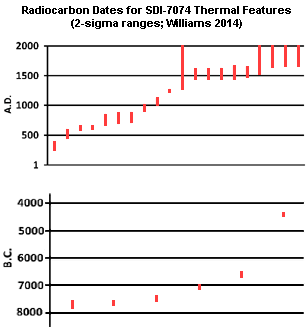AGAVE ROASTING
Roasting pits are numerous in eastern San Diego County, apparently testifying to extensive prehistoric exploitation of agave as a food resource (e.g. Castetter et al. 1938; Cook and Fulmer 1980; May 1987; Wallace and Taylor 1958). The importance of late-period agave use is well documented in the ethnographical record (e.g., Bean and Saubel 1972; Castetter et al. 1938; Chase 1919; Cuero 1968; Gifford 1931; Hicks 1963; Lee 1937). If it were to be demonstrated that agave roasting was not practiced or relatively little practiced during earlier periods, an explanation in terms of regional land use, subsistence values, or seasonal scheduling would be required to account for such an anomaly.
Anne Bastian (1977) obtained radiocarbon dates on six roasting pit features in the Davies Valley area of southwestern Imperial County. One of the dates was 475 ±140 B.P. (A.D. 1309-1630), and the other five were reported as post-A.D. 1900 (Shackley 1983).
 As an hypothesis for a study of roasting pits in the Mountain Springs area, just east of San Diego County, M. Steven Shackley (1983, 1984) proposed that local agave roasting had begun after A.D. 1500. Sixteen radiocarbon dates were obtained. One had a date of 11,537-11,232 B.C. and 12 had post-A.D. 1500 to modern ages. Of the remainder, one overlapped A.D. 1500 (A.D. 1460-1635) and two predated A.D. 1500 (A.D. 1297-1443 and A.D. 1318-1458). The hypothesis of a "short chronology" (after A.D. 1500) was considered to have been refuted. However, Shackley also noted the general correspondence between the available radiocarbon dates for agave roasting and periods during which, according to Michael R. Waters' (1983) chronology, Lake Cahuilla, the large, freshwater lake in the Imperial and Coachella valleys was either absent or substantially reduced in size (but cf. Laylander 1997a).
As an hypothesis for a study of roasting pits in the Mountain Springs area, just east of San Diego County, M. Steven Shackley (1983, 1984) proposed that local agave roasting had begun after A.D. 1500. Sixteen radiocarbon dates were obtained. One had a date of 11,537-11,232 B.C. and 12 had post-A.D. 1500 to modern ages. Of the remainder, one overlapped A.D. 1500 (A.D. 1460-1635) and two predated A.D. 1500 (A.D. 1297-1443 and A.D. 1318-1458). The hypothesis of a "short chronology" (after A.D. 1500) was considered to have been refuted. However, Shackley also noted the general correspondence between the available radiocarbon dates for agave roasting and periods during which, according to Michael R. Waters' (1983) chronology, Lake Cahuilla, the large, freshwater lake in the Imperial and Coachella valleys was either absent or substantially reduced in size (but cf. Laylander 1997a).
Dayle Cheever and Dennis R. Gallegos (1988) excavated a disturbed roasting pit in the Table Mountain area and obtained a radiocarbon date for its charcoal of A.D. 1180.
Brian Williams (2014; Cordova 2014) investigated 130 intact thermal features at site SDI-7074 in Jacumba Valley, acquiring radiocarbon dates from 26 of the features. Six of the features were dated to earlier than 4460 B.C., and the majority of the dates were earlier than A.D. 1500. The use of the features to roast agave could not be confirmed by paleobotanical evidence, but the association with agave processing seemed likely.
PROSPECTS
Future archaeological investigations may be able to shed further light on the extent of pre-Late Holocene agave roasting and whether or not the use of the resource was substantially confined to periods when Lake Cahuilla was absent.
 As an hypothesis for a study of roasting pits in the Mountain Springs area, just east of San Diego County, M. Steven Shackley (1983, 1984) proposed that local agave roasting had begun after A.D. 1500. Sixteen radiocarbon dates were obtained. One had a date of 11,537-11,232 B.C. and 12 had post-A.D. 1500 to modern ages. Of the remainder, one overlapped A.D. 1500 (A.D. 1460-1635) and two predated A.D. 1500 (A.D. 1297-1443 and A.D. 1318-1458). The hypothesis of a "short chronology" (after A.D. 1500) was considered to have been refuted. However, Shackley also noted the general correspondence between the available radiocarbon dates for agave roasting and periods during which, according to Michael R. Waters' (1983) chronology, Lake Cahuilla, the large, freshwater lake in the Imperial and Coachella valleys was either absent or substantially reduced in size (but cf. Laylander 1997a).
As an hypothesis for a study of roasting pits in the Mountain Springs area, just east of San Diego County, M. Steven Shackley (1983, 1984) proposed that local agave roasting had begun after A.D. 1500. Sixteen radiocarbon dates were obtained. One had a date of 11,537-11,232 B.C. and 12 had post-A.D. 1500 to modern ages. Of the remainder, one overlapped A.D. 1500 (A.D. 1460-1635) and two predated A.D. 1500 (A.D. 1297-1443 and A.D. 1318-1458). The hypothesis of a "short chronology" (after A.D. 1500) was considered to have been refuted. However, Shackley also noted the general correspondence between the available radiocarbon dates for agave roasting and periods during which, according to Michael R. Waters' (1983) chronology, Lake Cahuilla, the large, freshwater lake in the Imperial and Coachella valleys was either absent or substantially reduced in size (but cf. Laylander 1997a).